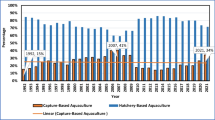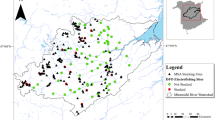Abstract
Modern salmon hatcheries in Southeast Alaska were established in the 1970s when wild runs were at record low levels. Enhancement programs were designed to help rehabilitate depressed fisheries and to protect wild salmon stocks through detailed planning and permitting processes that included focused policies on genetics, pathology, and management. Hatcheries were located away from significant wild stocks, local sources were used to develop hatchery broodstocks, and juveniles are marked so management can target fisheries on hatchery fish. Initially conceived as a state-run system, the Southeast Alaska (SEAK) program has evolved into a private, non-profit concept centered around regional aquaculture associations run by fishermen and other stakeholders that pay for hatchery operations through landing fees and sale of fish. Today there are 15 production hatcheries and 2 research hatcheries in SEAK that between 2005 and 2009 released from 474 to 580 million (average 517 million) juvenile salmon per year. During this same period commercial harvest of salmon in the region ranged from 28 to 71 million salmon per year (average 49 million). Contributions of hatchery-origin fish to this harvest respectively averaged 2%, 9%, 19%, 20%, and 78% for pink, sockeye, Chinook, coho, and chum salmon. Both hatchery and wild salmon stocks throughout much of Alaska have experienced high marine survivals since the 1980s and 1990s resulting in record harvests over the past two decades. Although some interactions between hatchery salmon and wild salmon are unavoidable including increasing concerns over straying of hatchery fish into wild salmon streams, obvious adverse impacts from hatcheries on production of wild salmon populations in this region are not readily evident.








Similar content being viewed by others
References
ADF&G (2009) Sustaining Alaska’s Fisheries: fifty years of statehood. State of Alaska, Alaska Dept. Fish and Game, Juneau, AK, p 74
Brenner RE, Moffitt SD (this issue) Hatchery straying studies in Prince William Sound, Alaska.
Cooley RA (1963) Politics and conservation: the decline of the Alaska salmon. Harper and Row, New York
Davis R, Burkett R (1989) Background of the genetic policy of Alaska Department of Fish and Game. ADF&G. FRED Division Report 95. Juneau, AK.
Davis R et al (1985) State of Alaska finfish genetics policy. Genetics Policy Review Team. ADF&G, Juneau
Heard WR (1996) Sequential imprinting in Chinook salmon: is it essential for homing fidelity? Bull Natl Res Inst Aquacult (Suppl. 2): 9–64.
Heard WR (2003) Alaska salmon enhancement: a successful program for hatchery and wild stocks. In: Nakamura Y, McVey JP, Fox S, Churchill K, Neidig C, Leber K (eds) Ecology of aquaculture species and enhancement of stocks, Proceedings of the 30th U. S.-Japan Aquaculture Panel, 3–4 December 2001. Florida Sea Grant TP-128, Mote Marine Lab. Tech. Rept. No.883, Sarasota, FL, pp 149–169.
Heard WR, Burkett R, Thrower F, McGee S (1995) A review of Chinook salmon resources in southeast Alaska and development of an enhancement program designed for minimal hatchery-wild stock interaction. Am Fish Soc Spec Symp 15:21–37
Hilborn R, Eggers D (2000) A review of the hatchery programs for pink salmon in Prince William Sound and Kodiak Island, Alaska. Trans Am Fish Soc 129:333–350
Holmes RA, Burkett RD (1996) Salmon stewardship: Alaska’s perspective. Fisheries 21:36–38
Johnson J, Sharp D, Joyce T, Moffitt S (2002) Prince William management area 2000 annual finfish management report. ADF&G Reg Infor Rep 2A02-02.
Josephson RP (2010) Observations of the distribution of hatchery chum salmon in Southeast Alaska, 1980–2006. Alaska Department of Fish and Game, Regional Information Report No. 5 J10-07. Juneau, AK, p 20.
Kaeriyama M (1989) Aspects of salmon ranching in Japan. Physiol Ecol Jpn, Spec 1:625–638
Klyashtorin LB, Rukhlov FN (1998) Long-term climate change and pink salmon stock fluctuation. N Pac Anadr Fish Comm Bull No.1:464–479.
Mantua NJ, Hare SR, Zhang Y, Wallace JM, Francis RC (1997) A Pacific inter decadal climate oscillation with impacts on salmon production. Bull Am Meteorol Soc 78(6):1069–1079
Meyers T (2003) Regulation changes, policies and guidelines for Alaska fish and shellfish heath and disease control. ADF&G Reg Infor Rep No. 5 J03-07, p 76.
McDowell Group (2010) Economic impacts of private nonprofit aquaculture associations in Southeast Alaska. McDowell Group, Inc. Juneau, AK, p 13.
McGee SG (2004) Salmon hatcheries in Alaska—plans, permits, and policies designed to provide protection for wild stocks. Am Fish Soc Symp 44:317–331
Piston AP, Heinl SC (in press) Hatchery chum salmon straying studies in Southeast Alaska, 2008–2010. ADF&G Fishery Data Series. Alaska Department of Fish and Game, Juneau, AK.
Roppel P (1982) Alaska’s salmon hatcheries 1891–1959. Alaska Historical Commission Studies in History No. 20, p 299.
Reese C, Hillgruber N, Sturdevent M, Wertheimer A, Smoker W, Focht R (2009) Spatial and temporal distribution and the potential for estuarine interactions between wild and hatchery chum salmon(Oncorhynchus keta) in Taku Inlet, Alaska. Fish Bull 107:433–450
Scientific Certification Systems (2006) Final MSC evaluation of Alaska commercial salmon fisheries performance indicators and scoring guidepost (PISG). available at: http://www.msc.org/track-a-fishery/certified/pacific/alaska-salmon/assessment-downloads-2/AKSalmonPISG_Final.pdf/view.
Smoker WW, Heard WR (2007) Productivity of Alaska’s salmon hatchery ocean ranching program and management of biological risks to wild Pacific salmon. In: Bert TM (ed) Ecological and genetic implications of aquaculture activities. Kluwer Academic Publications, Dordrecht
Sturdevant M, Fergusson E, Hillgruber N, Reese C, Orsi J, Focht R, Wertheimer A, Smoker W (this issue) Lack of trophic competition among wild and hatchery juvenile chum salmon during early marine residence in Taku Inlet, Southeast Alaska.
Volk EC, Schroder SL, Fresh KL (1990) Inducement of unique otolith banding patterns as a practical means to mass-mark juvenile Pacific salmon. p. 203–215. In: Parker NC, Giorgi AE, Heidinger RC, Jester JB Jr, Prince ED, Winans GA (eds) Fish-Marking Techniques. Am Fish Soc Symp 7, Bethesda, Maryland.
Wertheimer AC, Smoker WW, Joyce TL, Heard WR (2001) Comment: a review of the hatchery programs for pink salmon in Prince William Sound and Kodiak Island, Alaska. Trans Am Fish Soc 130:712–720
Wertheimer AC, Heard WR, Smoker WW (2004) Effects of hatchery releases and environmental variation on wild-stock productivity: consequences for sea ranching of pink salmon in Prince William Sound, Alaska. In: Leber KM, Kitada S, Svasand T, Blankenship HL (eds) Stock enhancement and sea ranching 2. Blackwell Science Ltd, Oxford, pp 307–326
White B (2010) Alaska salmon enhancement program 2009 annual report. Fishery Management Report No. 10–05. Alaska Department of Fish and Game, Juneau, p 47
Author information
Authors and Affiliations
Corresponding author
Rights and permissions
About this article
Cite this article
Heard, W.R. Overview of salmon stock enhancement in southeast Alaska and compatibility with maintenance of hatchery and wild stocks. Environ Biol Fish 94, 273–283 (2012). https://doi.org/10.1007/s10641-011-9855-6
Received:
Accepted:
Published:
Issue Date:
DOI: https://doi.org/10.1007/s10641-011-9855-6




